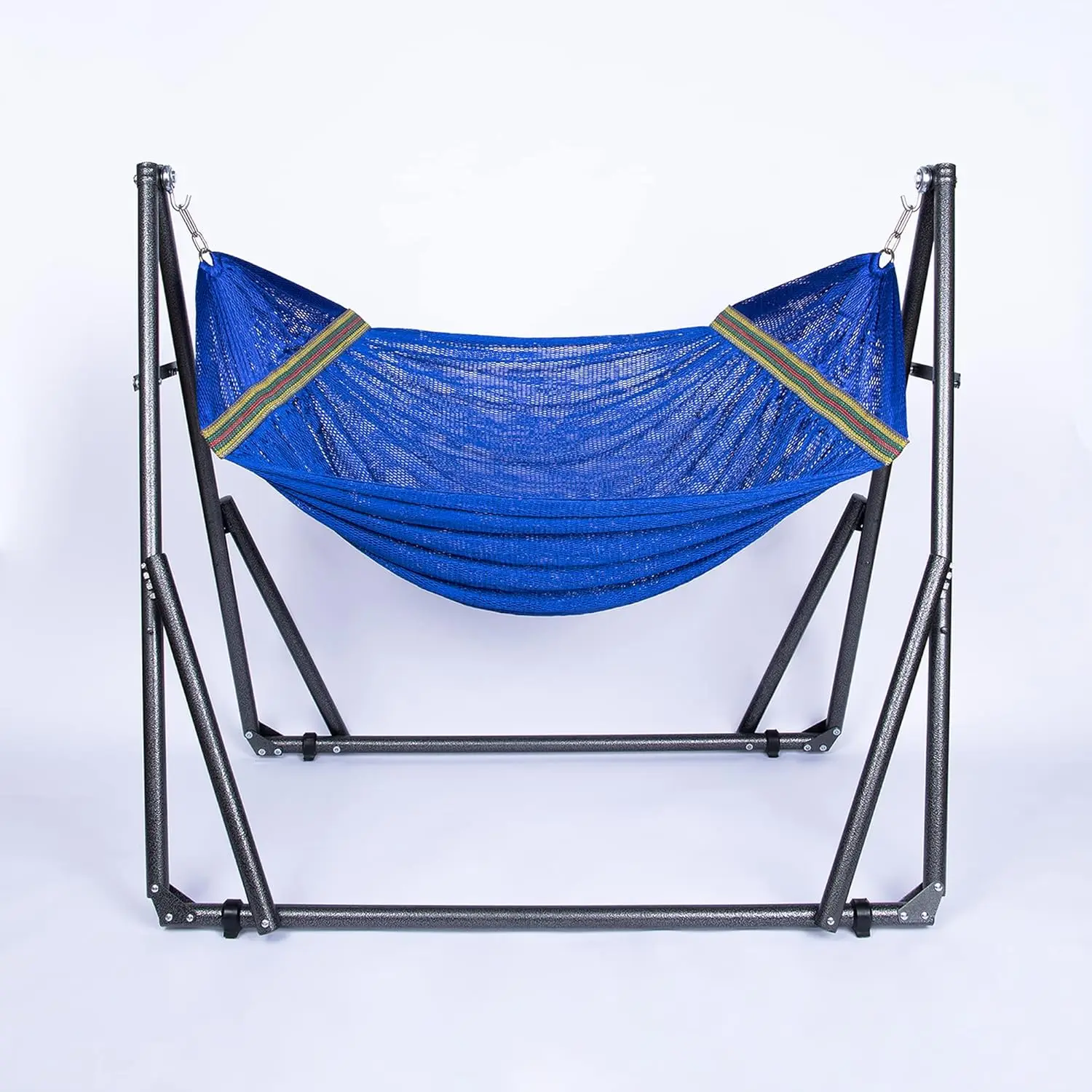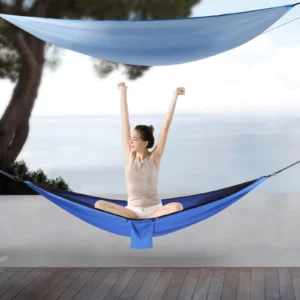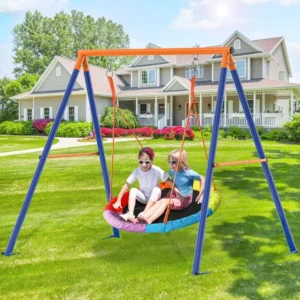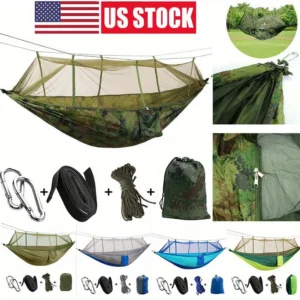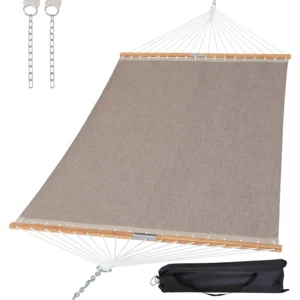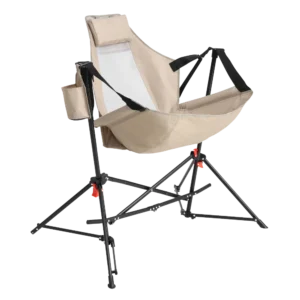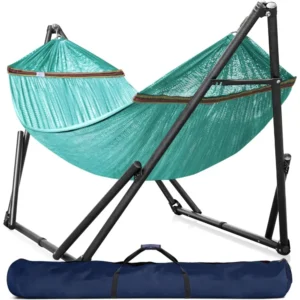Escape the Ordinary: The Freedom of Folding Travel Hammocks
Traditional travel accommodations often leave adventurers settling for uncomfortable hotel beds, limited relaxation options, and bulky gear that weighs down your journey. Enter the folding hammock – a revolutionary solution transforming how modern explorers rest, relax, and reconnect with their surroundings.
Folding hammocks represent the evolution of ancient comfort into modern portability. These compact, lightweight suspended sleeping or lounging systems pack down to a fraction of their deployed size, offering travelers an escape from conventional seating and sleeping arrangements. Unlike their traditional counterparts, which remain fixed in backyards or beach resorts, travel hammocks accompany you wherever adventure calls.
Imagine ending a long day of hiking in the mountains, unfolding your pocket-sized hammock, and within minutes, transforming two ordinary trees into your personal sanctuary above the ground. Or picture yourself creating an instant relaxation spot on an overcrowded beach, elevated above the hot sand while everyone else struggles with blankets and beach chairs.
The beauty of indoor outdoor hammock placement flexibility means your relaxation isn’t limited to specific environments – these versatile companions adapt to countless scenarios. Whether you’re a dedicated backpacker, weekend road-tripper, or urban explorer seeking moments of tranquility, folding hammock sets offer an unrivaled combination of comfort and convenience that traditional travel gear simply can’t match.
Let’s explore why these portable sanctuaries have become the secret weapon of savvy travelers worldwide.
The Ultimate Travel Advantage: Portability That Goes Anywhere
When it comes to travel gear, every inch and ounce matters – and this is where folding hammocks truly excel. Their remarkable portability transforms how you can experience comfort while traveling:
Folding hammocks boast impressive packed dimensions that make conventional travel bedding look cumbersome:
– Typically fold down to just 5×7 inches (12.7×17.8 cm) – roughly the size of a grapefruit
– Compress into integrated stuff sacks smaller than a water bottle
– Occupy minimal space in backpacks, suitcases, or even large pockets
The lightweight nature of these portable sanctuaries further enhances their travel-friendly appeal:
– Most weigh between 12-24 ounces (340-680 grams) – lighter than a standard water bottle
– Premium ultralight models can weigh as little as 7 ounces (198 grams)
– Even double-sized options typically remain under 2 pounds (907 grams)
This exceptional portability creates opportunities for different travel styles:
For backpackers, every gram counts, and a folding hammock provides luxurious comfort while adding negligible weight to your pack. Urban explorers can easily carry a hammock throughout a day of sightseeing, ready to create an instant relaxation spot in any park. Road trippers appreciate how little trunk space these compact wonders require, leaving room for other essentials.
The minimal packed size allows for spontaneous relaxation opportunities that bulkier rest options simply can’t match. You’re always prepared to create a comfortable spot wherever two suitable anchor points exist – turning ordinary travel moments into extraordinary experiences.
The how folding hammocks transform portability concept has revolutionized how travelers approach rest. Beyond just saving space, portable hammocks stands provide options even in environments without natural hanging points – truly making these systems adaptable to almost any travel scenario.
Quick Setup for Instant Relaxation: From Pack to Perfection
One of the most frustrating aspects of travel is complicated gear that wastes valuable exploration time. Folding hammocks eliminate this headache with remarkably simple setup that transforms from packed to perfect in minutes:
- Remove the hammock from its storage pouch (5 seconds)
- Locate suitable anchor points approximately 10-15 feet apart (30 seconds)
- Wrap tree-friendly straps around anchors and secure them (1-2 minutes)
- Attach the hammock ends to the straps using carabiners or integrated systems (30 seconds)
The entire process typically takes under 3 minutes for experienced users – a fraction of the time required to pitch even the simplest tent. Modern folding hammocks enhance this simplicity with thoughtfully designed features:
- Pre-attached carabiners eliminate fumbling with separate components
- Color-coded straps provide visual cues for proper setup
- Quick-adjust buckle systems allow for perfect tension without complex knots
- Compression straps double as hanging systems in some models
This intuitive design means even first-time users can achieve a comfortable setup with minimal effort. The “no tools required” aspect makes these hammocks particularly travel-friendly, with no tent poles, stakes, or mallets necessary.
The takedown process proves equally efficient – simply detach, fold, and stuff back into the integrated pouch. Many models feature quick-drying materials that resist moisture retention, preventing the damp, musty issues that plague other travel gear.
Perfect quick assembly folding hammocks enhance your travel experience by maximizing enjoyment time while minimizing setup frustration. For those prioritizing ultimate convenience, quick-setup hammock sets include all necessary components in one integrated system, further streamlining the process.
Ergonomic Comfort Beyond Traditional Sleep Options
The unique design of hammocks creates an ergonomic resting environment that traditional travel sleep systems simply can’t match. Unlike flat hotel mattresses or thin camping pads, a properly hung hammock contours perfectly to your body’s natural shape.
This ergonomic advantage creates several comfort benefits:
- Pressure point reduction by distributing weight evenly across your body
- Natural body alignment when lying diagonally across the hammock
- Gentle cradling that eliminates the discomfort of hard or uneven ground
- Subtle rocking motion that many users report enhances relaxation and sleep quality
- Elevated position that improves circulation for many sleepers
Many travelers discover that the diagonal laying technique transforms a hammock from curved banana shape to a remarkably flat, supportive surface. This positioning creates a natural position for your spine and eliminates the uncomfortable curve often associated with improper hammock use.
The customizable nature of hammock comfort also stands out. By adjusting hanging height, distance between anchor points, and body position, you can fine-tune your experience to personal preference – something impossible with pre-made beds or sleeping pads.
Beyond physical comfort, many users report improved sleep quality in hammocks. The gentle swaying motion appears to help people fall asleep faster and achieve deeper rest – a precious advantage when adjusting to new time zones or recovering from active travel days.
For those concerned about traditional hammock limitations, modern folding travel models address many common issues with wider designs, sturdy materials, and improved weight distribution to create truly comfortable sleep environments.

Versatility for Any Adventure: One Solution, Endless Possibilities
The remarkable adaptability of folding hammocks makes them the Swiss Army knife of travel comfort. Their versatility extends across environments, uses, and setups that other rest systems simply can’t match:
Environmental Adaptability:
– Forest settings with trees as natural anchors
– Beach environments between palm trees or posts
– Mountain terrain where flat ground for tents is scarce
– Urban parks with suitable structures or dedicated hammock posts
– Desert landscapes utilizing vehicles, rock formations, or portable stands
Multi-Functional Usage:
– Primary sleeping system for overnight adventures
– Daytime lounging spot for reading or enjoying views
– Impromptu seating for crowded events or beaches
– Shaded rest area with addition of a tarp or rainfly
– Social gathering spot that encourages conversation
Creative Anchor Solutions:
– Traditional tree-to-tree setups (most common)
– Vehicle roof racks or truck beds for roadside breaks
– Balcony railings or columns at vacation rentals
– Purpose-built hammock stands for anchor-free setups
– Structural building elements in urban environments
This adaptability means you’re never without a comfortable place to rest, regardless of your travel environment. While tents require flat, obstacle-free ground and chairs need stable surfaces, lightweight hammock sets transform almost any setting with suitable anchor points into your personal relaxation zone.
The “always have a seat” advantage proves particularly valuable in crowded tourist areas, fully-booked campgrounds, or uncomfortable waiting situations. Instead of sitting on hard ground or standing for hours, your portable hammock creates instant comfort wherever you find yourself.
For urban travelers or those visiting areas without natural anchor points, hammock stands provide a solution. While traditional stands can be bulky, modern folding stands complement the portability of travel hammocks, further expanding their versatility across environments.
Environmental Protection: Stay High, Dry, and Comfortable
Elevating yourself above the ground creates a protective barrier between you and several environmental discomforts that plague ground-dwelling travelers:
Ground Condition Protection:
– Complete separation from wet, muddy, or flooded terrain
– Avoidance of rocky, root-filled, or uneven ground that makes sleeping uncomfortable
– Protection from ground moisture that seeps through tent floors and sleeping pads
– Elimination of site preparation (clearing rocks, sticks, creating flat areas)
Wildlife and Pest Advantages:
– Reduced exposure to crawling insects, ants, and other ground-dwelling bugs
– Decreased likelihood of encounters with small animals or reptiles
– Minimal contact with tick-prone grass and undergrowth
– Natural barrier against many crawling pests without chemical repellents
Climate Comfort Benefits:
– Improved airflow around your entire body in hot, humid conditions
– Avoidance of ground-level humidity that makes tents feel clammy
– Reduced heat transfer from sun-baked ground in warm environments
– Natural ventilation that helps regulate sleeping temperature
The elevated position also supports “Leave No Trace” principles better than many ground setups. Properly hung hammocks with tree-friendly straps cause minimal environmental impact compared to tent platforms that compress soil and vegetation. This makes hammocks an environmentally conscious choice for responsible travelers concerned about their footprint.
This suspension advantage proves particularly valuable in regions with challenging terrain or wildlife concerns. From the insect-rich jungles of Central America to the wet forest floors of the Pacific Northwest, hammock installation requirements safety guide principles help travelers stay protected while minimizing environmental impact.
Nature Immersion: A Closer Connection to Your Surroundings
Unlike enclosed shelters that isolate you from your environment, hammocks create a unique sensory connection to your surroundings that enhances the travel experience:
When properly set up in natural settings, hammocks provide unobstructed panoramic views impossible to achieve in tents or hotel rooms. The elevated vantage point offers fresh perspectives on familiar landscapes, transforming ordinary scenes into memorable vistas.
The open design creates an immersive sensory experience beyond just visual connection:
– Feel gentle breezes against your skin instead of stagnant tent air
– Hear the full spectrum of natural sounds without fabric barriers
– Smell the authentic aromas of your environment, from forest pine to ocean salt
– Experience temperature and humidity as they naturally shift throughout the day
This sensory connection reaches its peak during nighttime use. While tent campers see only nylon walls, hammock users enjoy unparalleled stargazing opportunities. Many travelers report that their most memorable outdoor experiences happen while gently swaying under star-filled skies – a perspective impossible from traditional accommodations.
Beyond the aesthetic benefits, this nature immersion offers psychological advantages. Research suggests that direct nature connection reduces stress hormones, improves mood, and enhances overall well-being – benefits that align perfectly with travel relaxation goals.
The creating perfect hammock haven concept embraces this immersive philosophy, helping travelers maximize their connection to surroundings while maintaining comfort and safety. This balance of protection and openness creates a travel experience that neither fully enclosed nor fully exposed systems can match.
Travel-Ready Durability: Built for the Long Haul
Despite their lightweight packability, quality folding hammocks feature remarkably durable construction designed to withstand the rigors of travel:
Premium Materials Built for Performance:
– Ripstop nylon prevents small tears from expanding into system failures
– Parachute-grade materials (often 210T nylon) offer exceptional strength-to-weight ratio
– Triple-stitched seams distribute weight evenly across connection points
– Military-grade suspension systems handle far more than their rated capacity
– Weather-resistant fabrics that maintain integrity despite sun, rain, and humidity
Impressive Capacity Despite Minimal Weight:
– Single hammocks typically support 300-400 pounds (136-181 kg)
– Double models often rated for 400-500 pounds (181-227 kg)
– Suspension systems tested beyond stated weight limits for safety margin
– Reinforced attachment points prevent the most common failure areas
Weather and Environment Resistance:
– Quick-drying fabrics that prevent mold and mildew during extended trips
– UV-resistant materials that maintain integrity despite prolonged sun exposure
– Salt-water resistant construction for coastal adventures
– Temperature flexibility that performs in both hot and cold environments
The durability advantages extend to practical travel concerns as well. Quality hammocks withstand frequent packing/unpacking cycles that damage many travel products. Their simple construction means fewer breakable parts compared to complex camping gear with poles, zippers, and rigid components.
Maintenance remains minimal even during extended adventures – most hammocks require just occasional rinsing and air drying to maintain performance. This simplicity proves particularly valuable during long trips where gear care becomes challenging.
Ultimate guide ultralight hammock features explains how modern materials achieve this remarkable balance of minimal weight and maximum durability – a critical consideration for travelers who can’t afford gear failure in remote locations.
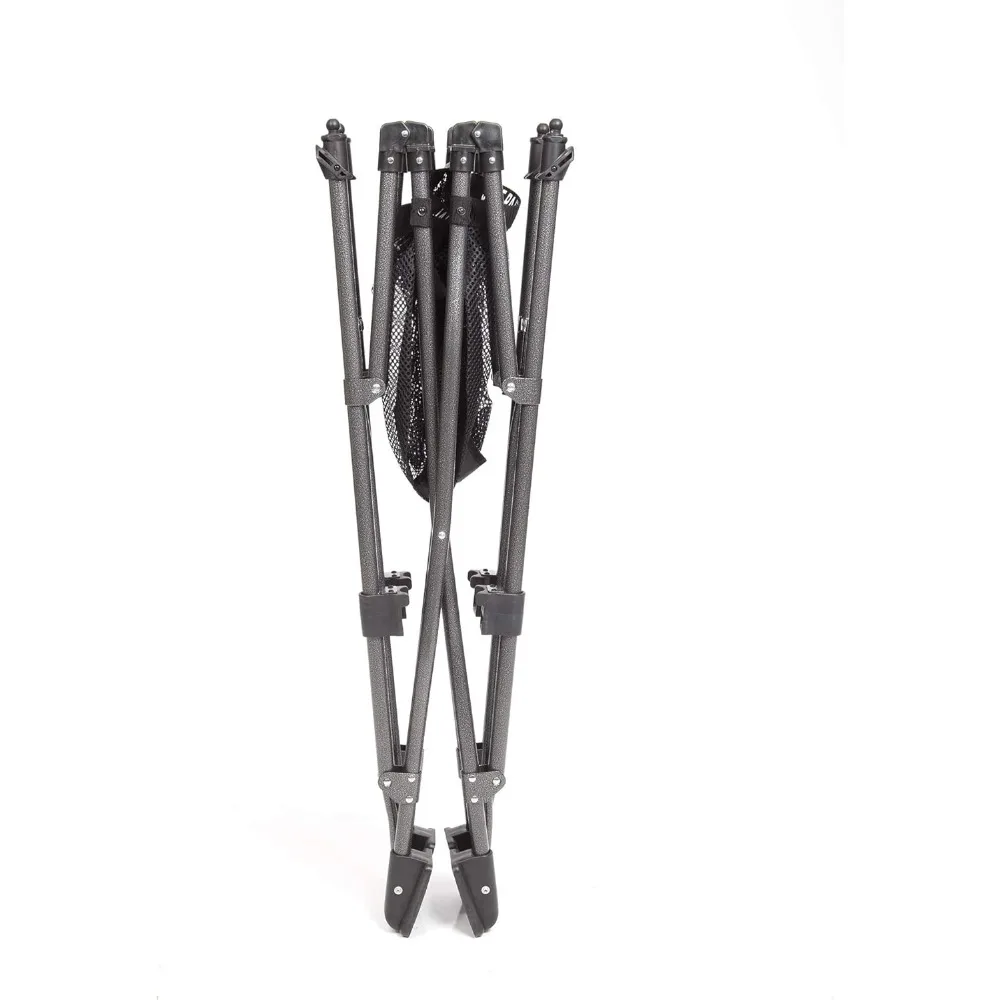
Compare and Contrast: How Folding Hammocks Stack Up Against Alternatives
Understanding how folding hammocks compare to other travel rest options helps identify when they provide optimal advantages:
| Feature | Folding Hammock | Tent | Sleeping Pad | Traditional Hammock |
|---|---|---|---|---|
| Packed Size | Extremely compact (grapefruit) | Moderate to large | Moderate | Bulky |
| Weight | 0.5-1.5 lbs (227-680g) | 2-5+ lbs (907g-2.3kg) | 0.5-2 lbs (227-907g) | 2-4 lbs (907g-1.8kg) |
| Setup Time | 2-3 minutes | 5-15+ minutes | 1-2 minutes | 5-10 minutes |
| Comfort Level | High (with proper hang) | Moderate (requires flat ground) | Low to moderate | High (bulky design) |
| Terrain Adaptability | Excellent (no flat ground needed) | Poor (requires clear, flat area) | Poor (requires relatively flat surface) | Good (complex setup) |
| Weather Protection | Minimal (requires accessories) | Excellent | None | Minimal |
| Temperature Range | Limited without accessories | Good to excellent | Limited | Limited |
| Environmental Impact | Minimal | Moderate | Minimal | Moderate |
Folding hammocks excel in scenarios where:
– Weight and packed size are primary concerns
– Quick setup and takedown are valuable
– Ground conditions are poor or uneven
– Natural anchor points are available
– Moderate weather conditions prevail
Traditional tents may prove advantageous when:
– Extreme weather protection is necessary
– No suitable anchor points exist
– Multiple people need shelter in one structure
– Ground conditions are favorable
– Privacy is a significant concern
The unique advantage of folding hammocks emerges from their specific combination of benefits – no other single system offers the same blend of ultralight portability, setup simplicity, comfort, and adaptability to challenging terrain. They represent a specialized solution that excels in specific travel contexts rather than a universal replacement for all shelter systems.
For travelers evaluating options, the indoor vs outdoor hammocks buyers guide provides detailed comparisons based on intended use, helping match the right system to specific travel needs and environments.
Essential Accessories: Optimize Your Hammock Experience
While a basic folding hammock provides exceptional comfort, strategic accessories extend functionality across various conditions:
Weather Protection Options:
– Lightweight rainflies/tarps (8-16 oz/227-454g) shield from precipitation and sun
– Asymmetrical designs maximize coverage while minimizing weight
– Multiple attachment configurations adapt to changing weather conditions
– Waterproof stuff sacks protect during transit and store wet components separately
Insulation Solutions:
– Underquilts (12-30 oz/340-850g) prevent “cold butt syndrome” by insulating beneath
– Top quilts provide above-body warmth more efficiently than sleeping bags
– Sleeping pad adapters create stable platforms for side-sleepers
– Reflective thermal barriers add warmth with minimal weight/bulk
Bug Protection Systems:
– Integrated bug nets envelop the hammock in insect-proof mesh
– Modular designs allow deployment only when needed
– Ridgelines support netting away from body for comfort
– Permethrin-treated options add chemical protection against persistent insects
Suspension Enhancements:
– Tree-friendly wide straps (>1.5”/3.8cm) prevent bark damage
– Adjustable buckle systems simplify setup and tension adjustments
– Extender straps accommodate wider anchor point spacing
– Hardware alternatives for non-tree setups (rock anchors, stand adapters)
Organizational Add-ons:
– Ridgeline organizers keep essentials within reach
– Gear slings protect equipment below your hammock
– Multi-pocket systems organize small items during extended stays
– Undercarriage storage nets maximize limited space
Camping Hammock Sets with Bug Net, Ultralight Camping Hammock Sets
$139.72 Select options This product has multiple variants. The options may be chosen on the product pageFolding Hammock Sets, Quick Setup Hammock Sets
Price range: $305.52 through $583.27 Select options This product has multiple variants. The options may be chosen on the product pageCamping Hammock Sets with Bug Net, Complete Camping Hammock Systems
Price range: $82.73 through $97.96 Select options This product has multiple variants. The options may be chosen on the product pageFolding Hammock Sets, Lightweight Hammock Sets
$295.80 Select options This product has multiple variants. The options may be chosen on the product pageDouble / Two Person Hammock Sets, Folding Hammock Sets, Heavy Duty Hammock Sets
Price range: $323.71 through $486.23 Select options This product has multiple variants. The options may be chosen on the product page
These accessories transform a basic folding hammock into a comprehensive shelter system adaptable to diverse environments. The modular nature allows travelers to pack only what specific conditions require – bringing bug protection for tropical adventures while leaving it behind for desert trips.
For those concerned about insects during their travels, camping hammock sets bug net provide integrated solutions that maintain the core hammock benefits while adding crucial protection.
Is a Folding Travel Hammock Right for You?
While folding hammocks offer remarkable advantages, they align better with certain traveler profiles and preferences:
Ideal For:
– Minimalist backpackers prioritizing weight/space savings
– Nature enthusiasts who value immersive outdoor experiences
– Travelers frequently encountering uneven or uncomfortable ground
– Adventure photographers seeking unique vantage points
– Digital nomads wanting comfortable outdoor workspaces
– Beach travelers tired of sand-covered towels and chairs
– Festival-goers needing compact, portable rest options
Consider Your Travel Style:
– Do you primarily stay in developed accommodations or natural settings?
– How important is gear weight and volume in your travel approach?
– Are you comfortable with a slight learning curve for optimal setup?
– Do your destinations offer suitable anchor points (trees, posts, etc.)?
– How important is connection to surroundings during rest periods?
Physical Considerations:
– Most users find hammocks extraordinarily comfortable, but individual preferences vary
– Side-sleepers may need accessories or diagonal positioning techniques
– Those with specific back concerns should test hammock comfort before extended travel
– Claustrophobic travelers generally prefer hammocks to enclosed shelters
A folding hammock might not be ideal if you exclusively travel to environments without anchor options, require complete weather isolation regardless of conditions, or strongly prefer perfectly flat sleeping surfaces without adaptation.
For those wondering about hammock compatibility with their specific travel plans, how to pack hammock hiking provides practical guidance for integrating these systems into various adventure styles.
Important Considerations Before You Swing
Understanding common hammock challenges helps travelers prepare appropriately:
Anchor Dependency Solutions:
– Scout locations in advance using satellite imagery to identify tree coverage
– Consider portable hammock stands for treeless environments (7-15 lbs/3.2-6.8 kg)
– Learn alternative setup methods using vehicles, buildings, or rock formations
– Research hammock-friendly parks and campgrounds at your destination
– Pack a lightweight ground setup as backup for uncertain locations
Comfort Optimization:
– Master the diagonal lay technique for flatter, more comfortable positioning
– Adjust suspension height and tension for optimal sag (30° angle from horizontal)
– Use proper width hammocks for your body size and sleeping style
– Practice setup before your trip to ensure comfort in the field
– Consider an integrated ridge line to maintain consistent sag
Weather Adaptability:
– Understand that basic hammocks excel in mild conditions but require accessories for extremes
– Layer appropriately below and above your body for temperature management
– Learn multiple tarp configurations for different precipitation patterns
– Consider seasonal appropriateness when planning hammock travel
Regulatory Awareness:
– Research local regulations regarding hammock use in parks and public spaces
– Use only tree-friendly straps (>1.5”/3.8cm wide) to comply with environmental regulations
– Respect posted rules about anchor point usage in managed areas
– Be prepared to explain low-impact practices to unfamiliar park staff
With proper preparation and knowledge, most limitations can be easily addressed. The key is understanding that hammocks represent a different approach to rest requiring specific techniques rather than inherent disadvantages.
For those concerned about setup locations, best indoor outdoor hammock locations provides creative solutions for finding suitable anchor points in various travel environments.
Finding Your Perfect Folding Hammock: Key Features to Consider
Selecting the optimal folding hammock requires evaluating several critical specifications:
Dimensional Considerations:
– Length: At minimum 8’ (244 cm) for average adults, 9’+ (275+ cm) for taller individuals
– Width: Single (4-5’/122-152 cm) vs. Double (5-6’/152-183 cm) affects stability and weight
– Weight capacity: Minimum 300 lbs (136 kg) for singles, 400+ lbs (181+ kg) for doubles
– Packed size: Premium models compress to grapefruit size or smaller
– Deployed size: Consider total space required between anchor points (typically 10-15’/3-4.6 m)
Material Quality Indicators:
– Fabric type: 210T ripstop nylon offers optimal strength-to-weight ratio
– Stitching pattern: Triple-stitched seams with reinforced attachment points
– Denier rating: Higher numbers indicate thicker, more durable fabric
– Weight-to-capacity ratio: Quality hammocks support 5-6x their own weight
Attachment Systems:
– Integrated carabiners vs. separate hardware (trade convenience for weight)
– Daisy-chain adjustment systems for easier setup
– Strap width (minimum 1.5”/3.8cm for tree protection)
– Knot-free designs for simpler adjustment
Additional Feature Considerations:
– Built-in stuff sack location (end-mounted vs. center)
– Integrated ridgelines for consistent setup
– Accessory attachment points for modularity
– Double-sided designs for shared use
Quality folding hammocks typically range from $30-100 depending on materials, capacity, and included accessories. While budget options exist, compromising on critical components like suspension systems or fabric strength can impact both safety and longevity.
For those concerned about indoor applications, is it safe hang hammock indoors addresses important structural considerations that apply to both permanent and temporary setups.
Setting Up for Success: Pro Tips and Techniques
Master these key techniques to maximize comfort and functionality:
The 30° Angle Rule: Hang suspension straps at approximately 30 degrees from horizontal for optimal sag – if your straps form a steeper angle, your hammock will be too tight for comfortable sleep.
Proper Hanging Height: Position the hammock so the lowest point sits at chair height (about 18”/46cm) when empty – this allows easy entry/exit while providing proper ground clearance when weighted.
The Diagonal Advantage: Lie at a 30-45° angle across the center line of the hammock to create a flatter sleeping surface and reduce shoulder squeeze.
Ridgeline Consistency: A non-weight-bearing cord running between hammock ends (at approximately 83% of total length) ensures consistent sag regardless of hanging distance.
Quick Safety Checks:
– Inspect anchor points for stability before each use
– Verify strap placement to prevent slipping
– Check carabiners/connectors are fully closed and locked
– Test weight gradually rather than with sudden force
Common setup mistakes to avoid:
– Hanging too tight (creates uncomfortable pressure points)
– Insufficient anchor strength (requires 2-3× your weight minimum)
– Improper strap width (damages trees, may violate regulations)
– Excessive height (complicates entry/exit, increases fall risk)
For those seeking perfect setup locations, perfect hammock placement home garden principles apply equally well to travel scenarios, helping identify ideal anchor points and positioning.
The Unexpected Benefits: Beyond Basic Relaxation
Beyond the obvious advantages, folding hammocks deliver several surprising benefits that enhance the travel experience:
Social Catalyst Effect:
Hammocks naturally attract curiosity and conversation, creating opportunities to connect with fellow travelers and locals alike. Their novel presence in unexpected locations often serves as an introduction to new friends and experiences.
Creative Space Transformation:
These portable systems convert ordinary locations into exceptional experiences – transforming a roadside rest stop into a peaceful retreat or a crowded beach into a personal sanctuary. This spatial alchemy enhances otherwise unmemorable locations.
Photographic Potential:
The unique perspective and aesthetic appeal of hammocks create distinctive travel photography opportunities. The contrast between suspended comfort and dramatic landscapes produces memorable images that stand out from typical travel documentation.
Mental Reset Facilitation:
The gentle rocking motion and elevated perspective provide a different psychological experience than ground-level rest. Many travelers report enhanced mindfulness, stress reduction, and mental clarity during hammock sessions – creating natural breaks in busy travel schedules.
Unplanned Adventure Enabler:
Having a comfortable rest option always available encourages exploration beyond planned itineraries. The confidence of knowing you can create comfort anywhere promotes spontaneous detours and discoveries that often become trip highlights.
These secondary benefits often surprise first-time hammock travelers, who frequently report that their portable sanctuary becomes not just practical gear but a central element of their travel identity and approach to exploration.

